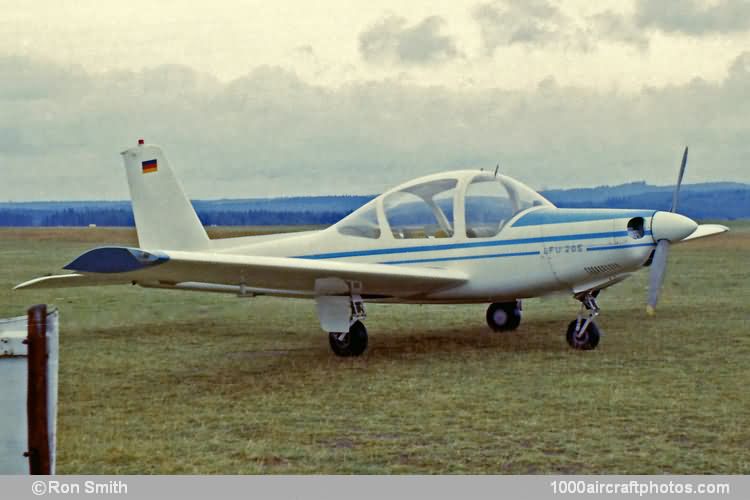This resulted in the design and construction of a four-seat experimental prototype light aircraft, the LFU 205, the entire airframe of which was constructed of glass fiber reinforced plastics. As well as offering a basic weight some 15% lower than that of a comparable all-metal aircraft, with a consequent improvement in performance, the employment of plastics offered considerable saving of man-hours in production and maintenance. Late in January 1968 an LFU 205 wing was subjected to dynamic loads equivalent to 36,000 flying hours without any evidence of material deterioration.
Development of the LFU 205 was undertaken by the three constituent companies, additional funds being provided by the Federal Ministries of Defense and Economics and by the Ministries of Economics of Baden-Württemberg and North Rhine-Westphalia. Construction of the LFU 205 prototype was started early in 1967, Pützer being responsible for manufacturing jigs and fixtures and RFB for the entire wing assembly. Messerschmitt-Bölkow-Blohm (into which Bölkow had been absorbed), as well as building the fuselage and undertaking final assembly of the prototype, was overall coordinator of the program and was responsible for design, flight testing and certification.
Registered D-ELFU the prototype LFU 205 (and sole aircraft produced) made its first flight on March 20, 1968. After cancelation of the program the aircraft was transferred in 1984 to the DFVLR (Deutsche Forschungs- und Versuchanstalt für Luft- und Raumfahrt, German Aerospace Research and Test Institute), which was renamed in 1989 to DLR (Deutsches Zentrum für Luft- und Raumfahrt e.V., German Aerospace Center), where it still is being used for wing flow research work. The following data is from Jane's 1970-1971."
Type: Experimental four-seat light aircraft.
Wings: Cantilever low-wing monoplane. Eppler 502 wing section. Thickness/chord ratio 15.72% throughout. Dihedral 4° 23' from roots. Incidence 2°. Wings have 7° sweep-forward from roots, glass fiber sandwich structure, consisting of a smooth outer skin and an inner skin laminated, hardened and wet-bonded together to form a rigid structure. Support of the two skins against the sandwich core is provided by a series of small tubes 0.40 in (10 mm) in diameter, wrapped in glass fiber and running parallel to the ribs. Each wing has three compartments built in this fashion (leading edge, center compartment, trailing edge), the center compartment being rectangular and extended at the root to enter the fuselage and act as the main spar. The three compartments are then enclosed in a single outer skin to give a smooth exterior. Frise-type ailerons and Fowler-type flaps are also of glass fiber plastics.
Fuselage: Semi-monocoque shell of wet-bonded glass fiber construction, thickness approx 0.60 in (15 mm), with an inner core of glass fiber covered tubes which lie parallel to the main frames. Each tube is impregnated with epoxy resin and has an inner tube of soft plastic that is inflated to force the outer tube against the inner and outer skins. These skins, of molded plastic, are laminated in position and then hardened and wet-bonded to give a rigid structure.
Tail unit: Single fin and rudder, with slight sweepback on leading edge of fin and shallow dorsal fairing from base of fin to rear of cockpit canopy. Trim-tab in rudder and tail plane. One-piece all-moving tail plane mid-mounted an rear fuselage. Similar sandwich construction to that of wings, utilizing a foam-plastic care.
Landing gear: Retractable tricycle type, with single wheel on each unit. Main wheels retract inward into wings, nose wheel rearward into fuselage.
Power plant: A 200 hp Lycoming IO-360-A1C four-cylinder horizontally-opposed air-cooled engine, driving a Hartzell two-blade constant-speed propeller of 6 ft 4 in (1.93 m) diameter. Fuel in two tanks in wings, with total capacity of 3.96 gal (192 l). Refueling point above each wing. Oil capacity 2.38 gal (9 l).
Accommodation: Side-by-side seating, in pairs, for four persons beneath rearward-sliding canopy. Space for 88 lb (40 kg) of baggage. Blind-flying instrumentation standard.
